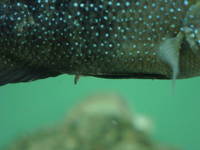- Oldfield, Ronald G. (x)
- Search results
Search results
Show moreThe 300-gallon (1131-liter) aquarium that held nine adult Herichthys minckleyi. One small male was observed performing alternative male mating behavior "sneaking" -- attempting to fertilize the eggs of a female in the process of mating with a large male.
Show less
Show moreThe small "sneaking" male Herichthys minckleyi was the only fish in the aquarium that exhibited a swollen genital papilla, except the spawning female and the large dominant male.
Show less
Show moreThe small "sneaking" male Herichthys minckleyi exhibited a swollen genital papilla while it was performing sneaking behavior again in 2013. The smaller heterospecific fish in the aquarium in 2013 were Green Sunfish, Lepomis cyanellus, which were also spawning at the time that sneaking behavior was observed in Herichthys minckleyi.
Show less
Show moreLarge male and female Herichthys minckleyi spawning in 2013 (video) the smaller heterospecific fish in the aquarium in 2013 were Green Sunfish, Lepomis cyanellus, which were also spawning at the time that sneaking behavior was observed in Herichthys minckleyi.
Show less
Show moreLarge male and female Herichthys minckleyi spawning in 2013 (image 1) the smaller heterospecific fish in the aquarium in 2013 were Green Sunfish, Lepomis cyanellus, which were also spawning at the time that sneaking behavior was observed in Herichthys minckleyi.
Show less
Show moreLarge male and female Herichthys minckleyi spawning in 2013 (image 2) the smaller heterospecific fish in the aquarium in 2013 were Green Sunfish, Lepomis cyanellus, which were also spawning at the time that sneaking behavior was observed in Herichthys minckleyi.
Show less
Show moreLarge male and female Herichthys minckleyi spawning in 2013 (image 3) the smaller heterospecific fish in the aquarium in 2013 were Green Sunfish, Lepomis cyanellus, which were also spawning at the time that sneaking behavior was observed in Herichthys minckleyi.
Show less
Show moreA close-up view of the brood site while a small male Herichthys minckleyi performs alternative male mating behavior. The small male arrives at the site just after the female lays a row of eggs, and before the large male has had a chance to fertilize them.
Show less
Behavioral studies have often examined parental care by measuring phenotypic plasticity of behavior within a species. Phylogenetic studies have
Show moreEnglish
Behavioral studies have often examined parental care by measuring phenotypic plasticity of behavior within a species. Phylogenetic studies have compared parental care among species, but only at broad categories (e.g., care vs. no care). Here we provide a detailed account that integrates phylogenetic analysis with quantitative behavioral data to better understand parental care behavior in the Cuatro Ciénegas cichlid, Herichthys minckleyi. We found that H. minckleyi occurs in a clade of sexually monochromatic or weakly dichromatic monogamous species, but that male and female H. minckleyi have dramatically different reproductive coloration patterns, likely as a result of sexual selection. Furthermore, we found that males are polygynous; large males guard large territories, and smaller males may attempt alternative mating tactics (sneaking). Finally, compared to the closely related monogamous Rio Grande cichlid, H. cyanoguttatus, males of H. minckleyi were present at their nests less often and performed lower rates of aggressive offspring defense, and females compensated for the absence of their mates by performing higher levels of offspring defense. Body color, mating system, and parental care in H. minckleyi appear to have evolved after it colonized Cuatro Ciénegas, and are likely a result of evolution in an isolated, stable environment.
Show less
Show moreSmall male Herichthys minckleyi performing sneaking behavior in 2013 (video) the smaller heterospecific fish in the aquarium in 2013 were Green Sunfish, Lepomis cyanellus, which were also spawning at the time that sneaking behavior was observed in Herichthys minckleyi.
Show less
Show moreSmall male Herichthys minckleyi performing sneaking behavior in 2013 (image 1) the smaller heterospecific fish in the aquarium in 2013 were Green Sunfish, Lepomis cyanellus, which were also spawning at the time that sneaking behavior was observed in Herichthys minckleyi.
Show less
Show moreSmall male Herichthys minckleyi performing sneaking behavior in 2013 (image 2) the smaller heterospecific fish in the aquarium in 2013 were Green Sunfish, Lepomis cyanellus, which were also spawning at the time that sneaking behavior was observed in Herichthys minckleyi.
Show less
Show moreSmall male Herichthys minckleyi performing sneaking behavior in 2013 (image 3) the smaller heterospecific fish in the aquarium in 2013 were Green Sunfish, Lepomis cyanellus, which were also spawning at the time that sneaking behavior was observed in Herichthys minckleyi.
Show less
Show moreSmall male Herichthys minckleyi performing sneaking behavior in 2013 (image 4) the smaller heterospecific fish in the aquarium in 2013 were Green Sunfish, Lepomis cyanellus, which were also spawning at the time that sneaking behavior was observed in Herichthys minckleyi.
Show less
Show moreA small male Herichhys minckleyi observed earlier performing "sneaking" alternative male mating behavior is here seen performing \"satellite\" male behavior: driving away additional males that might also try to sneak in to fertilize eggs of the female that is trying to mate with the large, dominant male.
Show less

















